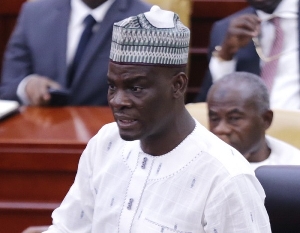- Home - News
- TWI News | TV
- Polls
- Year In Review
- News Archive
- Crime & Punishment
- Politics
- Regional
- Editorial
- Health
- Ghanaians Abroad
- Tabloid
- Africa
- Religion
- Election 2020
- Coronavirus
- News Videos | TV
- Photo Archives
- News Headlines
- Press Release
General News of Sunday, 22 March 2015
Source: starrfmonline.com
Statement: Water distribution capacity lags far behind supply
Ghana has made significant progress in the coverage of clean and safe water supply to citizens over the years. The country has been touted to have met the Millennium Development Goals (MDGs) ahead of time with an 85 percent national coverage against an MDG target of 75 percent according to the MDG Joint Monitoring Platform (JMP).
The Ghana WatSan Journalists Network (GWJN) has however identified some bottlenecks which still exist in the supply of clean water to communities and households.
In a three-day field research carried out by the members; lasting from Thursday, March 19, to Saturday, March 21) GWJN came across massive evidence of water supply into these communities.
The field work covered four strategic areas where the recently completed water facilities around Accra are meant to serve.
These include the Shai Osudoku area, Teshie-Nungua (including Lashiebi and Spintex Road), Adenta-Madina-Frafraha area) as well as Dome-Kwabenya-East, West and North Legon areas.
From the preliminary reports filed by members, one theme which keeps running through is the lack of access by households to water in these areas, although there is ample proof that water supply to these communities has improved greatly.
Indeed, some households and individuals described how relieved they have become, since December, when water started flowing through their taps regularly.
However, paradoxically, many other households and individuals still face lack of supply due to the ineffective or non-existent distribution network.
One major factor contributing to this is the fast-pace of growth and expansion of these communities. However, there is also the issue of broken pipes which has resulted in the spilling of treated water meant for human consumption.
In La-Nkwantanan electoral area near Madina for instance, out of 105 Secondary distribution networks only 19 are working currently, with a whopping 86 broken down. Checks have revealed that one unit of these costs about GHc 400 (four thousand Ghana cedis|), which means poor households and communities cannot afford to raise investments into such networks in the short term.
Also important is the massive numbers of burst pipe-lines discovered in these communities.
These have caused many households to be denied easy access to safe and clean water that has been invested in for them.
We therefore wish state in our preliminary findings that the massive improvement in water supply capacity and real water supply to these communities notwithstanding, distribution capacity lags far behind the capacity of supply was a result of the growth in the size of these communities and the obsolete or non-existent distribution networks.
We therefore call on the government and stakeholders to take steps to address the serious lag in distribution networks which denies households easy access to the potable and safe water meant for them.
.Lastly, there is a growing discontent among residents of some of these communities about the manner in which they are billed.
Many alleged that as soon as they started receiving water supply in December 2014, the Ghana Water Company Limited (GWCL) started sending them bills covering the previous five (5) years that they had not received water supply.
So deep is the discontent that some households would even want to return to the era of tanker supplies which “we are used to” instead of being “cheated” by the GWCL). All these issues affect reliability and the quality of the water provided to residents especially in urban areas.
The theme for this year’s World Water Day celebration which falls on Sunday, March 22, is “Water and Sustainable Development”. But with the current trend of lack of reliable and potable water supply to many communities, the country’s development is at risk.
Many communities are still without constant water supply and those who do, have their water contaminated due to water pollution. There are several communities with leaking and burst pipelines.
This puts the health of consumers at risk of contracting and the increase in waterborne diseases. Already the country is struggling to contain the Cholera outbreak which killed scores of people in 2014.
Some deaths and cases have also been recorded this year. These developments only mean that infrastructure in the water sector hasn’t been the best and investment in improving water provision and sanitation has been low.
Members of the Ghana Water and Sanitation Journalists Network (GWJN) who continue to draw attention of stakeholders to water and sanitation issues therefore calls on government and its Stakeholders to increase investments into the water and sanitation sector to address these critical challenges in order to prevent needless disease outbreaks and deaths. Spending the already scarce resources on fighting Cholera which can be prevented The government in particular must ensure that budgetary allocations for the sector are disbursed judiciously and efficiently in order to bring its health, economic and other social benefits to the country.
Water is life, let’s live it.











